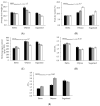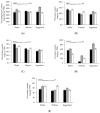Effects of Genotype, Storage Temperature and Time on Quality and Compositional Traits of Cherry Tomato
- PMID: 33255529
- PMCID: PMC7760833
- DOI: 10.3390/foods9121729
Effects of Genotype, Storage Temperature and Time on Quality and Compositional Traits of Cherry Tomato
Abstract
The experiment addressed the effects of two storage temperatures, namely 10 (T10) and 20 °C (T20), on main quality and functional traits of three cherry tomato cultivars ('Eletta', 'Sugarland' and 'Ottymo'), after 0 (S0), 7 (S7) and 14 (S14) days of storage. At T10 both fruit weight and firmness were better retained during storage. At S14, T10 promoted fruit Chroma and overall fruit color deviation (ΔE*ab). Total polyphenols content (TPC) of fruits peaked at S7 (4660 mg GAE kg-1 DW) then declined at S14 (by 16%), with the highest values recorded at T10. Lycopene showed a similar trend, but with a higher average concentration recorded at T20 (488 mg kg-1 DW). β-carotene content peaked at S14, irrespective of the storage temperature. At S14, the concentrations of phytoene and phytofluene were higher at T20 (48.3 and 40.9 mg kg-1 DW, respectively), but the opposite was found at S7. 'Sugarland' and 'Ottymo' showed the highest ΔE*ab along storage, with the former cultivar proving the highest TPC and lycopene content, whereas 'Eletta' did so for phytoene and phytofluene. Our results suggest that unravelling the possible functional interactions among these three carotenoids would allow for a better orientation of breeding programs, targeting the phytochemical evolution of tomatoes during refrigerated storage.
Keywords: Solanum lycopersicum L.; carotenoids; fruit quality; refrigerated storage; total polyphenols content.
Conflict of interest statement
The authors declare no conflict of interest.
Figures



Similar articles
-
Effects of a plant-derived biostimulant application on quality and functional traits of greenhouse cherry tomato cultivars.Food Res Int. 2022 Jul;157:111218. doi: 10.1016/j.foodres.2022.111218. Epub 2022 Apr 5. Food Res Int. 2022. PMID: 35761540
-
Postharvest quality and bioactive properties of tomatoes (Solanum lycopersicum) stored in a low-cost and energy-free evaporative cooling system.Heliyon. 2019 Aug 10;5(8):e02266. doi: 10.1016/j.heliyon.2019.e02266. eCollection 2019 Aug. Heliyon. 2019. PMID: 31440600 Free PMC article.
-
Improved functional and nutritional properties of tomato fruit during cold storage.Saudi J Biol Sci. 2020 Jun;27(6):1467-1474. doi: 10.1016/j.sjbs.2020.03.026. Epub 2020 Apr 9. Saudi J Biol Sci. 2020. PMID: 32489282 Free PMC article.
-
Vapour Application of Sage Essential Oil Maintain Tomato Fruit Quality in Breaker and Red Ripening Stages.Plants (Basel). 2021 Dec 1;10(12):2645. doi: 10.3390/plants10122645. Plants (Basel). 2021. PMID: 34961116 Free PMC article.
-
Non-destructive assessment of flesh firmness and dietary antioxidants of greenhouse-grown tomato (Solanum lycopersicum L.) at different fruit maturity stages.Saudi J Biol Sci. 2020 Oct;27(10):2839-2846. doi: 10.1016/j.sjbs.2020.07.004. Epub 2020 Jul 9. Saudi J Biol Sci. 2020. PMID: 32994744 Free PMC article.
Cited by
-
Scion and Rootstock Differently Influence Growth, Yield and Quality Characteristics of Cherry Tomato.Plants (Basel). 2020 Dec 7;9(12):1725. doi: 10.3390/plants9121725. Plants (Basel). 2020. PMID: 33297446 Free PMC article.
-
Can Microbial Consortium Applications Affect Yield and Quality of Conventionally Managed Processing Tomato?Plants (Basel). 2022 Dec 20;12(1):14. doi: 10.3390/plants12010014. Plants (Basel). 2022. PMID: 36616143 Free PMC article.
-
Qualitative Characteristics and Functional Properties of Cherry Tomato under Soilless Culture Depending on Rootstock Variety, Harvesting Time and Bunch Portion.Foods. 2024 May 8;13(10):1450. doi: 10.3390/foods13101450. Foods. 2024. PMID: 38790750 Free PMC article.
-
Quality Traits and Nutritional Components of Cherry Tomato in Relation to the Harvesting Period, Storage Duration and Fruit Position in the Truss.Plants (Basel). 2023 Jan 9;12(2):315. doi: 10.3390/plants12020315. Plants (Basel). 2023. PMID: 36679028 Free PMC article.
-
Screening, Identification, and Quantification of Nutritional Components and Phytochemicals in Foodstuffs.Foods. 2021 Jan 8;10(1):125. doi: 10.3390/foods10010125. Foods. 2021. PMID: 33435630 Free PMC article.
References
-
- Food and Agriculture Organization of the United Nations [(accessed on 26 September 2020)]; Available online: http://www.fao.org/faostat/en/#home.
-
- Mauro R.P., Lo Monaco A., Lombardo S., Restuccia A., Mauromicale G. Eradication of Orobanche/Phelipanche spp. seedbank by soil solarization and organic supplementation. Sci. Hortic. 2015;193:62–68. doi: 10.1016/j.scienta.2015.06.038. - DOI
-
- Cainelli N., Ruperti B. Biochemistry and molecular biology in fruits during cold storage. Annu. Plant Rev. Online. 2019;2:659–688.
-
- Mauro R.P., Agnello M., Rizzo V., Graziani G., Fogliano V., Leonardi C., Giuffrida F. Recovery of eggplant field waste as a source of phytochemicals. Sci. Hortic. 2020;261:109023. doi: 10.1016/j.scienta.2019.109023. - DOI
LinkOut - more resources
Full Text Sources
Research Materials

